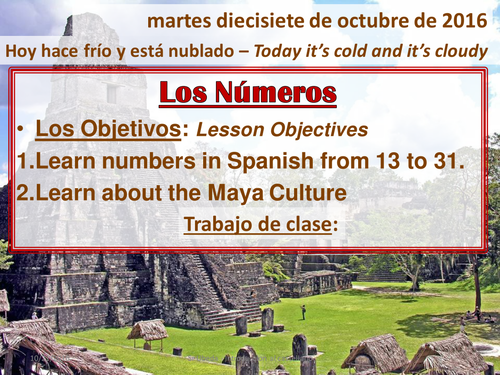



Two lessons on Spanish numbers from 13 to 31 and a series of activities introducing the Maya culture and Mayan numerals. It includes a power point presentation, a worksheet with extensions for the medium/high ability and a simplified version for the low ability, plus three support sheets.
Special attention has been put on improving cultural awareness of the Spanish speaking world, in line with the new GCSE specification.
Learning Objectives:
1. Learn numbers in Spanish from 13 to 31.
2. Learn about the Maya Culture
Success Criteria:
* By the end of this lesson all students will be able to remember Spanish numbers from 13 to 20.
* By the end of this lesson most students will be able to remember Spanish numbers from 21 to 30.
* By the end of this lesson some students will have learnt some facts about the Maya civilisation.
List of activities:
1. Mistake recognition task in which students have to find spelling, agreement and/or grammar mistakes on a set of five sentences. The slide includes a timer, some extra vocabulary for support and its is differentiated by outcome (ALL must complete 1-3, MOST will complete 1-4 and SOME will complete 1-5 in the time given: between 5'-10'). This task is to be peer-assessed: grade and target.
2. Presentation of numbers from 13 to 30. Teacher to elicit three patterns (i.e. "Dieci" + number 1-9).
3. Listening task. Teacher to read/spell the names of five individuals and to state their ages. Revision of the Spanish alphabet. Teacher to elicit the pattern for numbers from 31-39 ("Treinta y" + number 1-9). This task is to be self-assessed.
4. Oral Practice ("¿Qué número es?"). Teacher to check pupil's understanding (no "hands-up").
5. Vocabulary Matching-Up. This task is to be completed in groups of 3 or more. Teacher to elicit cognate recognition.
6. Short presentation of the Maya Culture in the TL (CLIL), followed by a matching up of new words and pictures.
7. Dictionary task, followed by word classification (noun, verb and adjective). This task is to be completed in pairs. Praise points to be awarded to the couple that finishes first.
8. Fill-in the gaps exercise, recycling all vocabulary from tasks 5-7. It could be executed as a listening task, as I have inserted in the presentation a clip from the Museo Nacional de Antropología in Ciudad de México (http://www.youtube.com/watch?v=uZGxQAO8FLQ)
9. Presentation on Mayan numerals. Students are provided with a section of a Maya Codex and have to find as many numbers as they can spot.
10. AfL Exercise: Students to reflect on their own learning.
Follow-up: Students should be encouraged to develop their own research on the Maya culture, either individually or in groups.
Special attention has been put on improving cultural awareness of the Spanish speaking world, in line with the new GCSE specification.
Learning Objectives:
1. Learn numbers in Spanish from 13 to 31.
2. Learn about the Maya Culture
Success Criteria:
* By the end of this lesson all students will be able to remember Spanish numbers from 13 to 20.
* By the end of this lesson most students will be able to remember Spanish numbers from 21 to 30.
* By the end of this lesson some students will have learnt some facts about the Maya civilisation.
List of activities:
1. Mistake recognition task in which students have to find spelling, agreement and/or grammar mistakes on a set of five sentences. The slide includes a timer, some extra vocabulary for support and its is differentiated by outcome (ALL must complete 1-3, MOST will complete 1-4 and SOME will complete 1-5 in the time given: between 5'-10'). This task is to be peer-assessed: grade and target.
2. Presentation of numbers from 13 to 30. Teacher to elicit three patterns (i.e. "Dieci" + number 1-9).
3. Listening task. Teacher to read/spell the names of five individuals and to state their ages. Revision of the Spanish alphabet. Teacher to elicit the pattern for numbers from 31-39 ("Treinta y" + number 1-9). This task is to be self-assessed.
4. Oral Practice ("¿Qué número es?"). Teacher to check pupil's understanding (no "hands-up").
5. Vocabulary Matching-Up. This task is to be completed in groups of 3 or more. Teacher to elicit cognate recognition.
6. Short presentation of the Maya Culture in the TL (CLIL), followed by a matching up of new words and pictures.
7. Dictionary task, followed by word classification (noun, verb and adjective). This task is to be completed in pairs. Praise points to be awarded to the couple that finishes first.
8. Fill-in the gaps exercise, recycling all vocabulary from tasks 5-7. It could be executed as a listening task, as I have inserted in the presentation a clip from the Museo Nacional de Antropología in Ciudad de México (http://www.youtube.com/watch?v=uZGxQAO8FLQ)
9. Presentation on Mayan numerals. Students are provided with a section of a Maya Codex and have to find as many numbers as they can spot.
10. AfL Exercise: Students to reflect on their own learning.
Follow-up: Students should be encouraged to develop their own research on the Maya culture, either individually or in groups.
Something went wrong, please try again later.
This resource hasn't been reviewed yet
To ensure quality for our reviews, only customers who have purchased this resource can review it
Report this resourceto let us know if it violates our terms and conditions.
Our customer service team will review your report and will be in touch.
£5.00
